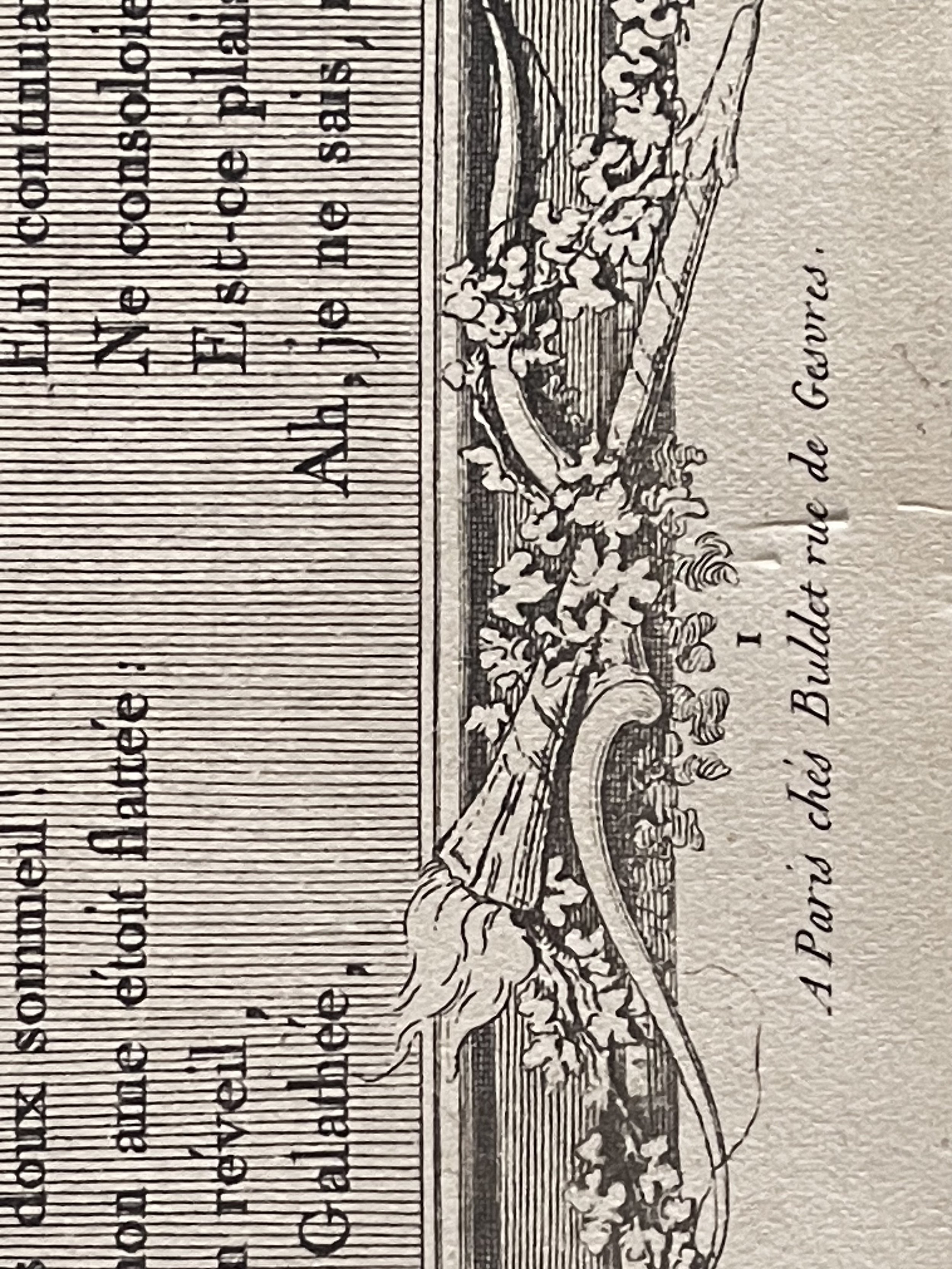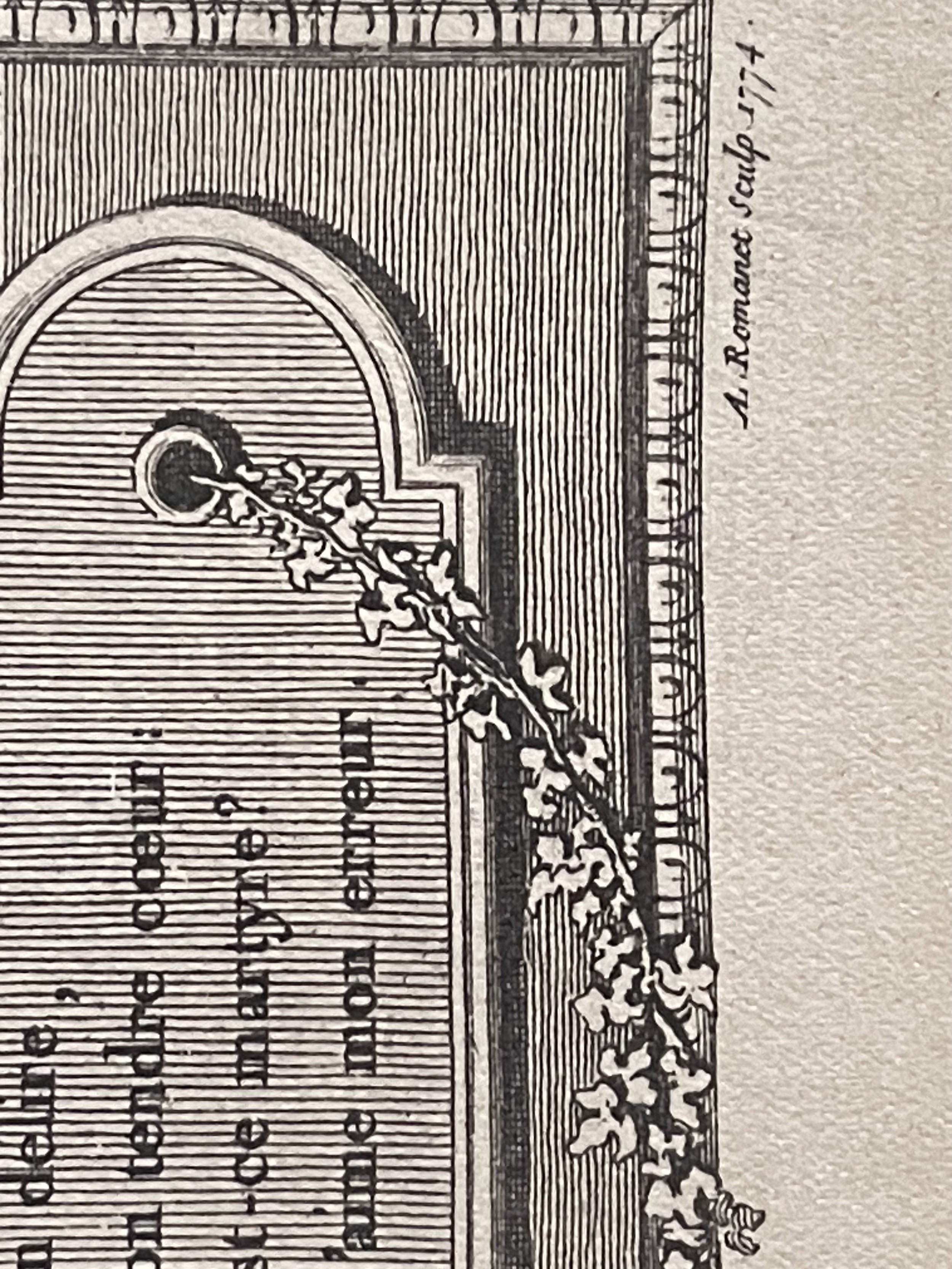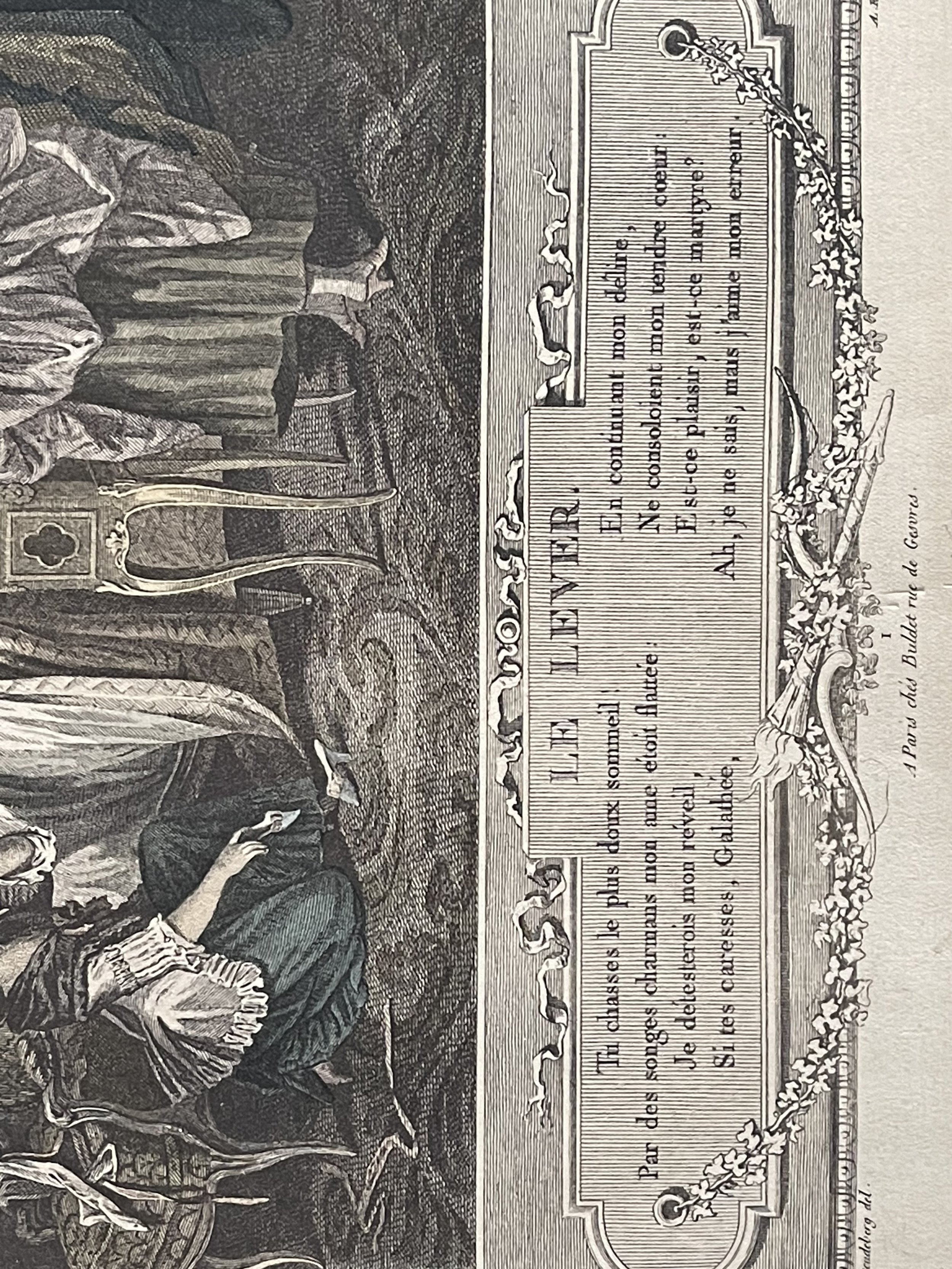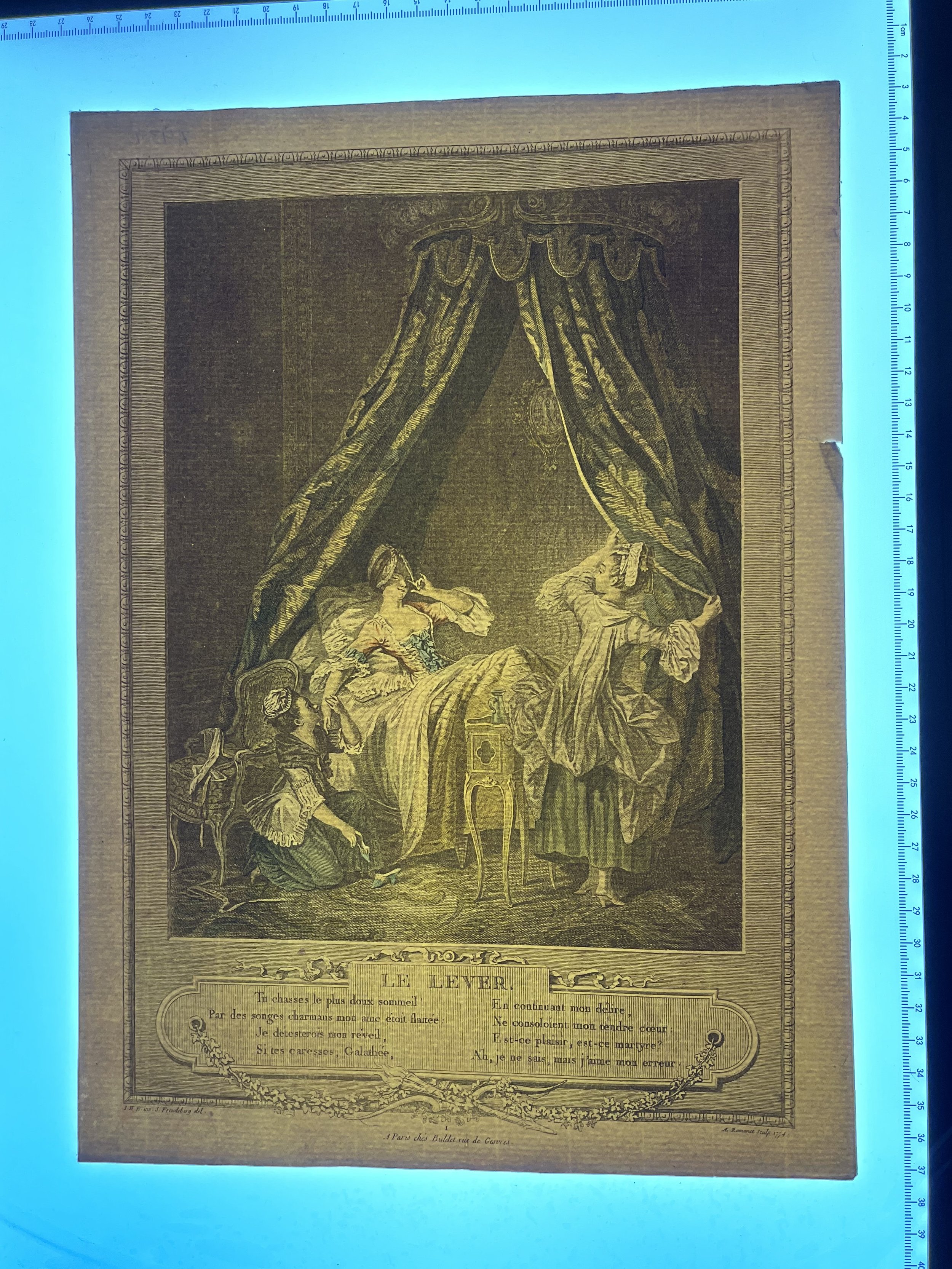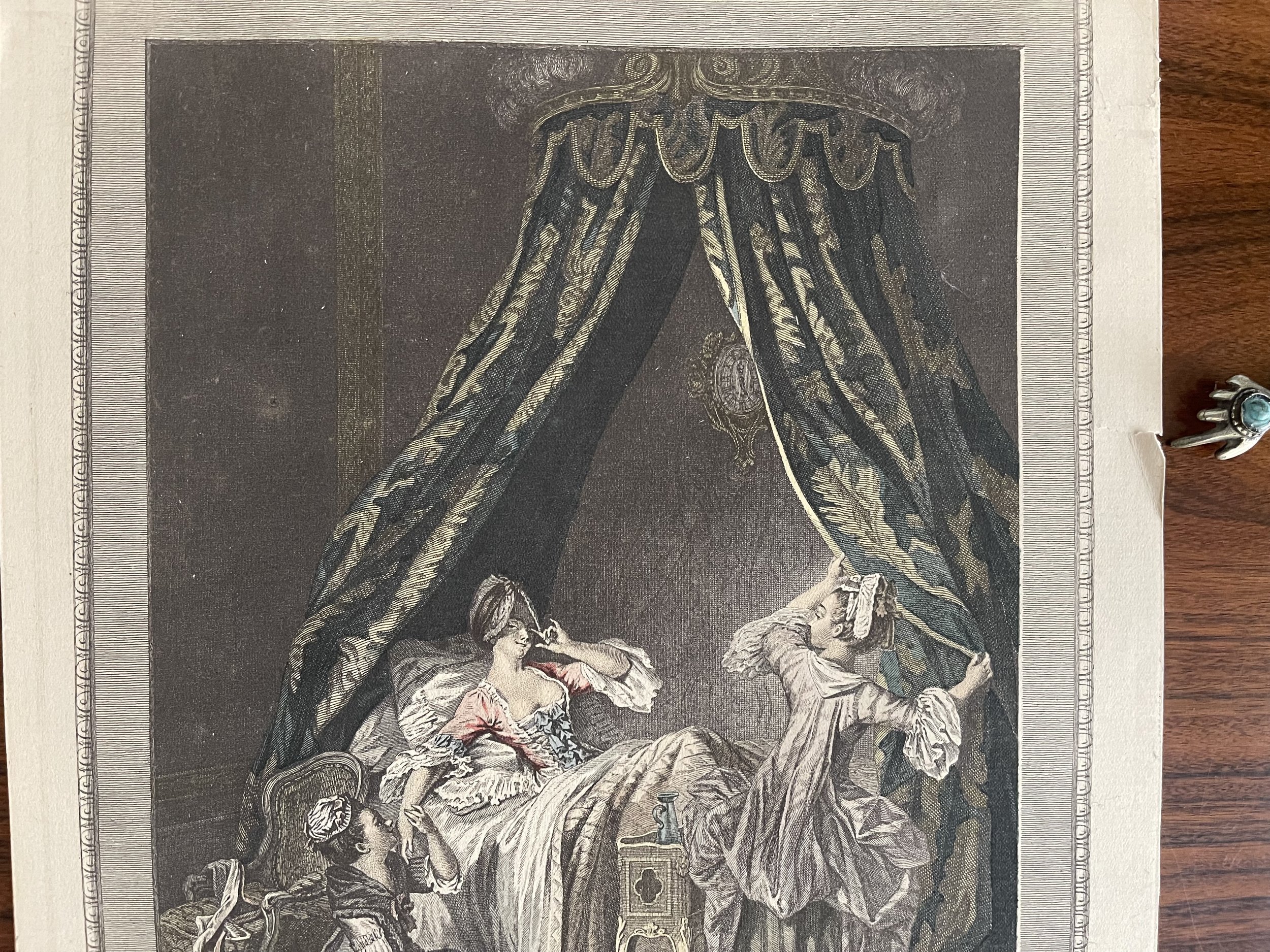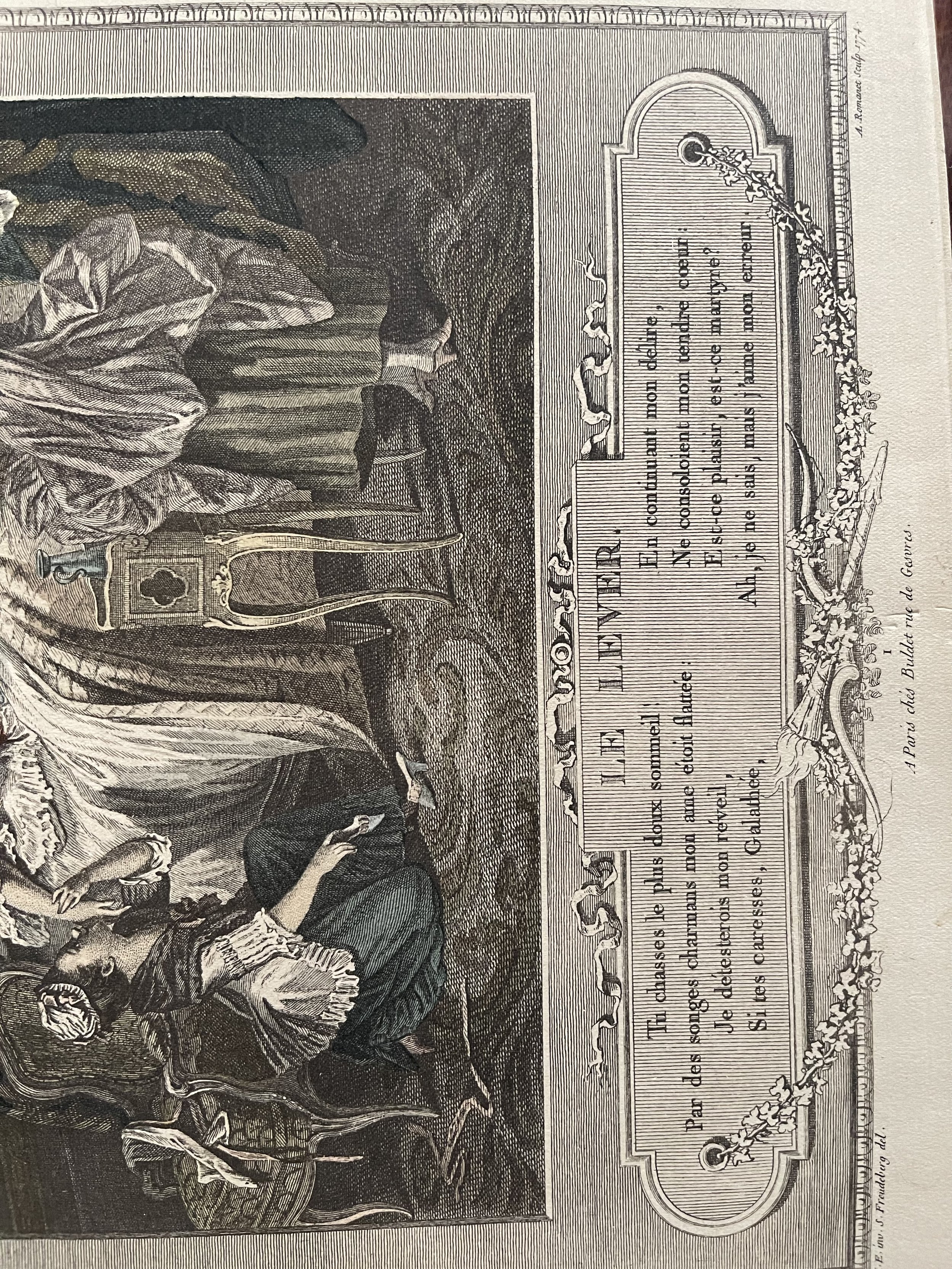Le Lever - 'waking up and rising' - Antoine-Louis Romanet - 1774
Hand Coloured. 18thC French Etching from an engraving by A L Romanet Le Lever Hand Coloured. C 1790
From a series of paintings Monument du Costume Physique et Moral de La fin des. Dix-Hutiefne siecle.
A copy is in the British Museum
This is an engraved etching by Antoine-Louis Romanet 1742-1810, one of the leading engravers of this period.
The original artist Sigmund Friedberg was Swiss and lived from 1745-1801. He was commissioned to produce a series to educate the not so well off into the customs and habits of the rich and famous. Here we have a noble woman waking up in a canopy bed while two servants are bustling around her.
Sigmund did not finish all his paintings, nor the series. Some were left unfinished and were completed by other artists. In this case it is also signed bottom left by JHE, Johann Heinrich Eberts. 1720-1803 Occasional etcher but commissioner of works of art. Mainly a banker in Paris from 1756
The term Le Lever, refers to waking up and rising.
Antoine-Louis Romanet (7 January 1742, Paris - 1 April 1807, Saint-Maurice) was a French engraver, designer, and miniaturist.
He was descended from a line of engravers, long established in Paris. One of his cousins was married to the famous engraver, Jean-Georges Wille, who gave him his first lessons. In 1765, through Wille, he obtained an apprenticeship in Basel with Christian von Mechel, where he learned advanced techniques for using the burin.
In 1767, he left Basel then, in 1770, married Françoise-Nicole née Mancel, the daughter of an innkeeper on the Rue Saint-Jacques, with Wille as witness. They had at least four children; two daughters and two sons. The police came to his home in 1776, arrested him, and took him to his studio, where they confiscated the copper plates and proofs of an engraving depicting a certain "Mme. de Saint-Vincent". She had filed a complaint in the context of an "affair of morals". The police report also cited his dealer, named "Isabey". In 1781, he went into business with the art dealer, Jean-Baptiste-Pierre Lebrun, who was himself a painter. At one point, he was forced to sue for payment. He was a regular exhibnitor at the " Salon de la Correspondance" (1779-1787), organized by the writer, Pahin de la Blancherie .
The Swiss miniaturist, Marc-Louis Arlaud, became his student in 1797. Romanet also worked in that genre, but remained almost entirely known for his engravings. During the latter part of his career, his workshop was located at the Place du Pont-Saint-Michel, which disappeared during the creation of the Boulevard Saint-Michel in the 1860s.
Small tear in border shown by the pointer, price and condition has been adjusted. Pointer not in the sale.
Hand Coloured. 18thC French Etching from an engraving by A L Romanet Le Lever Hand Coloured. C 1790
From a series of paintings Monument du Costume Physique et Moral de La fin des. Dix-Hutiefne siecle.
A copy is in the British Museum
This is an engraved etching by Antoine-Louis Romanet 1742-1810, one of the leading engravers of this period.
The original artist Sigmund Friedberg was Swiss and lived from 1745-1801. He was commissioned to produce a series to educate the not so well off into the customs and habits of the rich and famous. Here we have a noble woman waking up in a canopy bed while two servants are bustling around her.
Sigmund did not finish all his paintings, nor the series. Some were left unfinished and were completed by other artists. In this case it is also signed bottom left by JHE, Johann Heinrich Eberts. 1720-1803 Occasional etcher but commissioner of works of art. Mainly a banker in Paris from 1756
The term Le Lever, refers to waking up and rising.
Antoine-Louis Romanet (7 January 1742, Paris - 1 April 1807, Saint-Maurice) was a French engraver, designer, and miniaturist.
He was descended from a line of engravers, long established in Paris. One of his cousins was married to the famous engraver, Jean-Georges Wille, who gave him his first lessons. In 1765, through Wille, he obtained an apprenticeship in Basel with Christian von Mechel, where he learned advanced techniques for using the burin.
In 1767, he left Basel then, in 1770, married Françoise-Nicole née Mancel, the daughter of an innkeeper on the Rue Saint-Jacques, with Wille as witness. They had at least four children; two daughters and two sons. The police came to his home in 1776, arrested him, and took him to his studio, where they confiscated the copper plates and proofs of an engraving depicting a certain "Mme. de Saint-Vincent". She had filed a complaint in the context of an "affair of morals". The police report also cited his dealer, named "Isabey". In 1781, he went into business with the art dealer, Jean-Baptiste-Pierre Lebrun, who was himself a painter. At one point, he was forced to sue for payment. He was a regular exhibnitor at the " Salon de la Correspondance" (1779-1787), organized by the writer, Pahin de la Blancherie .
The Swiss miniaturist, Marc-Louis Arlaud, became his student in 1797. Romanet also worked in that genre, but remained almost entirely known for his engravings. During the latter part of his career, his workshop was located at the Place du Pont-Saint-Michel, which disappeared during the creation of the Boulevard Saint-Michel in the 1860s.
Small tear in border shown by the pointer, price and condition has been adjusted. Pointer not in the sale.
Hand Coloured. 18thC French Etching from an engraving by A L Romanet Le Lever Hand Coloured. C 1790
From a series of paintings Monument du Costume Physique et Moral de La fin des. Dix-Hutiefne siecle.
A copy is in the British Museum
This is an engraved etching by Antoine-Louis Romanet 1742-1810, one of the leading engravers of this period.
The original artist Sigmund Friedberg was Swiss and lived from 1745-1801. He was commissioned to produce a series to educate the not so well off into the customs and habits of the rich and famous. Here we have a noble woman waking up in a canopy bed while two servants are bustling around her.
Sigmund did not finish all his paintings, nor the series. Some were left unfinished and were completed by other artists. In this case it is also signed bottom left by JHE, Johann Heinrich Eberts. 1720-1803 Occasional etcher but commissioner of works of art. Mainly a banker in Paris from 1756
The term Le Lever, refers to waking up and rising.
Antoine-Louis Romanet (7 January 1742, Paris - 1 April 1807, Saint-Maurice) was a French engraver, designer, and miniaturist.
He was descended from a line of engravers, long established in Paris. One of his cousins was married to the famous engraver, Jean-Georges Wille, who gave him his first lessons. In 1765, through Wille, he obtained an apprenticeship in Basel with Christian von Mechel, where he learned advanced techniques for using the burin.
In 1767, he left Basel then, in 1770, married Françoise-Nicole née Mancel, the daughter of an innkeeper on the Rue Saint-Jacques, with Wille as witness. They had at least four children; two daughters and two sons. The police came to his home in 1776, arrested him, and took him to his studio, where they confiscated the copper plates and proofs of an engraving depicting a certain "Mme. de Saint-Vincent". She had filed a complaint in the context of an "affair of morals". The police report also cited his dealer, named "Isabey". In 1781, he went into business with the art dealer, Jean-Baptiste-Pierre Lebrun, who was himself a painter. At one point, he was forced to sue for payment. He was a regular exhibnitor at the " Salon de la Correspondance" (1779-1787), organized by the writer, Pahin de la Blancherie .
The Swiss miniaturist, Marc-Louis Arlaud, became his student in 1797. Romanet also worked in that genre, but remained almost entirely known for his engravings. During the latter part of his career, his workshop was located at the Place du Pont-Saint-Michel, which disappeared during the creation of the Boulevard Saint-Michel in the 1860s.
Small tear in border shown by the pointer, price and condition has been adjusted. Pointer not in the sale.
Code : A939
Cartographer : Cartographer / Engraver / Publisher: Antoine-Louis Romanet
Date : Publication Place / Date - 1774
Size : Sheet size: Image Size: 35 x 25 cm
Availability : Available
Type - Genuine - Antique
Grading A-
Where Applicable - Folds as issued. Light box photo shows the folio leaf centre margin hinge ‘glue’, this is not visible otherwise.
Tracked postage, in casement. Please contact me for postal quotation outside of the UK.

